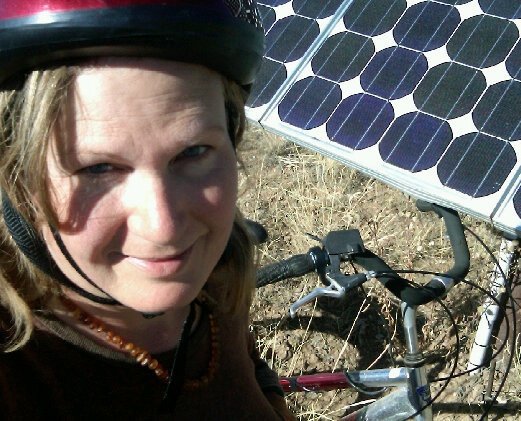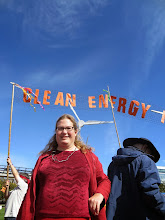The Eighty Percent Solution
Is it ambitious to set a goal to reduce our carbon emissions 80% by 2050, or even 2020 as some have proposed? I have reduced my own carbon emissions 86% in the space of two months, and in the process will be saving $5000 a year. It’s better for my health and brings me closer to the community around me. I’ll describe the steps I am taking to do this, including electricity, heat, transportation, and food.
An old adage called the 80/20 rule suggests that twenty percent of any effort will provide eighty percent of the benefit. Our energy production, homes, and personal habits all work to make it easy to use lots of juice, and emit lots of carbon. 20% of that energy use, it seems, is providing 80% of the benefit. Our very wastefulness here in the west is our biggest hope, because we have lots of room for improvement. It actually saves quite a bit of money to use less energy overall, and get the energy we use from lower impact sources.
In order to avoid waste, and discover where investments can have the most impact, we must be able to measure the carbon we’re emitting. Running the numbers for my own usage, estimating kilowatt hours, gallons of gasoline, cords of wood, and so forth took a lot of googling, a lot of care to distinguish tons of carbon from tons of carbon dioxide, a lot of converting from “standard” units to metric. Since many of us don’t have degrees in engineering, we can all just have apps on our phones that tell us how much we are using in real time, and over the course of the day and year.
I’ve reduced my carbon emissions over 80%, and I want everyone else to do the same right now. I now get my electricity from solar panels. Some of my friends are tied into the grid, and get a check in the mail each month instead of an electric bill. Others run windmills, or small scale hydroelectric systems. Conservation is the key to making solar work. Solar costs more per kilowatt hour, but I’m using 80% fewer kilowatt hours.
Buildings can be retrofitted quickly, if we have the will to do so. Some foreclosed houses in the distant suburbs might have to be recycled, and monster-mega homes broken into smaller units. PV panels, solar hot water, extra insulation, and edible landscaping will dominate the list of changes, along with much more efficient appliances. Solar panels will make your house worth a lot more money, and lots easier to sell.
The fleet of cars can also be replaced quickly, with a plug-in hybrid version of cash for clunkers, car sharing, walkable cities, public transit, electric bikes and mini-cars. The point is, once we dig in and get going with this, we’ll make big changes, fast. The Big Retrofit will be big business, because it will save people big bucks.
I cut the wire, and what was that wire connected to? A mountaintop blasted apart in West Virginia, valleys filled with toxic rubble, generations removed from the land. Neutrons flying around, doing strange things to matter, waste to last a million years, candy for a terrorist. A towering dam, flooding a sacred, beautiful, and historic canyon. I cut the wire. I reduced my consumption of coal, nuclear, and big hydro by 100%.
In my new place, I’m completely off the grid, and enjoy free electricity from the sun. But at my old house, electricity comprised only 14% of my carbon emissions. Heating the house with wood and propane counted more than double that. I had a gorgeous house, with definitely more space than I needed, impossible to keep warm in the depth of a Colorado winter. Shutting off half of the rooms helped. The wood was standing dead or down aspen, gathered from the forest floor. Now this could be considered “renewable”, but I was indeed mining the forest’s carbon store, which could take decades or longer to replace. Each cord of firewood contains just over half a ton of carbon, which when burned becomes over two tons of carbon dioxide. I burned four cords of wood last winter. I am no longer burning wood for heat, which in itself has reduced my carbon emissions by 25%.
Propane has three atoms of hydrogen for each atom of carbon, which works out to almost half the energy coming from burning hydrogen. It’s still a fossil fuel, not ideal. I’d rather have a solar hot water and space heater, perhaps supplemented by a super efficient pellet stove burning beetle-killed tress-- but until then I must sit content in my smaller, super-insulated cabin, having reduced my carbon emissions from heating by about 80%.
Crunching the numbers revealed the true carbon beast in my life—the SUV. The Jeep was a gift, and a wonderful in how it could get me all over Colorado’s four wheel roads, and over the snow in the winter. But by itself it ate more carbon than the entire house, 53% of the total! Even when I subtracted for carpooling, it took up over four tons of carbon a year.
There simply isn’t an electric vehicle that will replace a Jeep. But I can replace most of the Jeep’s capabilities. I live in a fairly remote area, so to get around to nearby towns I’ve got an electric bike. Since I’ll charge it off of the solar power, it will let me get around with no carbon impact. Riding together automatically reduces each individual’s impact by half- or more if there’s more than two people. Ride-sharing, plus bus and train, must be my means of long distance travel for now. These comprise the bulk of my new carbon budget, but I’ve reduced my total carbon footprint from transportation—by about 80%.
A Jeep can go lots of places… how do I replace this capability? A horse can go even more places, deep into the nearby wilderness. Methane emissions are about half that of a cow, and with proper composting horse poop can help build the soil. Emissions from seven horses produce the same amount of global warming as a ton of carbon, so a single horse would raise my new carbon budget about 12%, and still keep me above an 80% reduction overall.
A bigger realizable dream is to pool resources with my local community to set up a car-sharing cooperative, with an electric car or van. We can use the internet to schedule its use, with a big carpool down to the farmer’s market each week. This is quite do-able anywhere, so now we will have car-mates, who may or may not be the same people as our housemates. This is already happening in places like Portland, Oregon with something called the Flexcar. There’s a pool of cars, and you can check one out for as long as you need it. Since you only pay for what you use, there’s a good reason to use less.
Not having a car in the driveway all the time reduces impulsive or non-necessary travel. This increases walking and biking, decreases impulse shopping, saves money, reduces traffic and air pollution… oh, yes, and slows the increase of the greenhouse effect. You get to meet your neighbors and ride places with them.
I cut the gas hose. What was on the other end of that gas hose? Nasty refineries, the stink of a gas station, square miles of asphalt, lost in a parking garage. Cars designed to wear out, breakdowns that seem to sense whenever you have a few bucks to spare, crooked mechanics, overpriced parts. Miles and miles of brake lights, giant trucks belching diesel smoke swerving too close, trash everywhere by the side of the road. Dead animals and deadly crashes on the side of the road every day, never knowing when you will be next. The beauty of Prince William Sound forever polluted, tar balls on the beach, rainbows in the gutter. The horrors of Nigeria’s oil fields, villages poisoned, activists killed. The empire of oil, armies on the move, missiles flying, towers falling in revenge. Politicians in a headlock, bills weakened in congress, elections stolen… I cut the gas hose.
The carbon impact of food is the hardest to measure. I wasn’t able to include it in my numbers. Organic agriculture, done properly, can build the soil… but how many miles must it travel to get here? Living as I do in a remote place, it’s of great importance to grow as much food as I can in windowsill, greenhouse, and garden, eat local meats and wild game, and gather what food the forest has to offer. Last year I harvested 70 pounds of pine nuts! Here in Colorado’s Altiplano, our farmers grow quinoa and potatoes, and you can get a respectable crop of veggies even in the short growing season. Even though I can’t cut my rations the way I cut the size of my house, the goal is to be able to measure the carbon emissions of my diet, and reduce them by at least half.
Mother Earth is very strong—she will survive a brief pulse of carbon dioxide, as she has in the past. But our civilizations are fragile, and a change of a degree can send noble empires down to ruins. And worst of all, our children and grandchildren must pay the highest price. We face an extra-ordinary challenge that will last a century or more. To avoid catastrophe, we need to make a steep reduction in our emissions right now. And we can, this very year, reduce our emissions by quite a bit.
Americans have the biggest changes to make, the biggest debt of past emissions. It’s a huge challenge, but if there’s anything Americans love, it’s a challenge. Even if we don’t want to admit we were wrong in the first place, we can still lead the world in cleaning up our past mistakes—since we’re the most wasteful, we can make the biggest reduction. Go U.S.A.! Fixing the mess left by the 20th century is one of the biggest economic opportunities for the 21st.
If you feel like 80% is overwhelming, how about half? I bet you can reduce your carbon emissions by half, right away, without giving up too much. I believe in you, and the world is counting on you. It’s necessary, it’s your patriotic duty, it’s the right thing to do.


No comments:
Post a Comment